Timothy Johnson (1792-1871)
Timothy Johnson was born on 28 Jun 1792 in Middletown, Middlesex, Connecticut, as the sixth child of Timothy Johnson and Grace Johnson. He had seven siblings, namely: Ebenezer, Grace, Hannah, Dorothy, Elizabeth, Cyrus, and Esther Johnson.
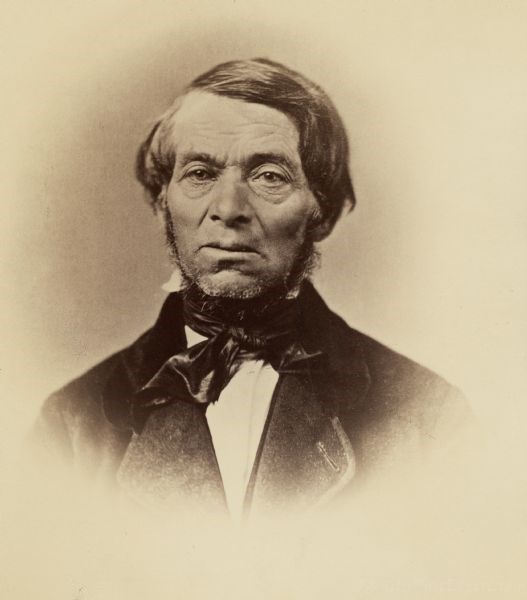
When he was about ten-years old, his family moved from Middletown to Turin, Lewis, New York.
A decade later, the War of 1812 occurred. The war was a conflict between the United States and the British Empire. Sometimes considered the second fight for independence, the War of 1812 started on 18 Jun 1812, a week before Timothy Johnson’s 20th birthday. The war continued until 1815. Several things led to the war. Britain was in a war with France and did not like the United States trading with their enemy. So, they tried to restrict U.S. trade. The British also had a practice of removing seaman from U.S. merchant ships and forcing them to serve on behalf of the British. The U.S. did not approve of that practice, known as impressement. And, the British did not like that the U.S. was aggressively expanding. They went so far as to encourage Native American hostilities against that expansion in the West.
The war took place on the American-Canadian border along the Great Lakes and the Saint Lawrence River, at sea with attacks on each other’s merchant ships, and in the American South and Gulf Coast. Northern New York, where Timothy lived, was in the thick of it. According to “A History of Lewis County” by Hough, “The settlements [of Lewis County] were frequently alarmed by rumors of Indian invasions from Canada. The route through the county became a thoroughfare of armies, and every resource of the valley was called into use to supply the troops passing through, or the garrisons on the frontier.“
During the war, Timothy Johnson served as a Private in Captain Clapp’s Company of the New York Militia.
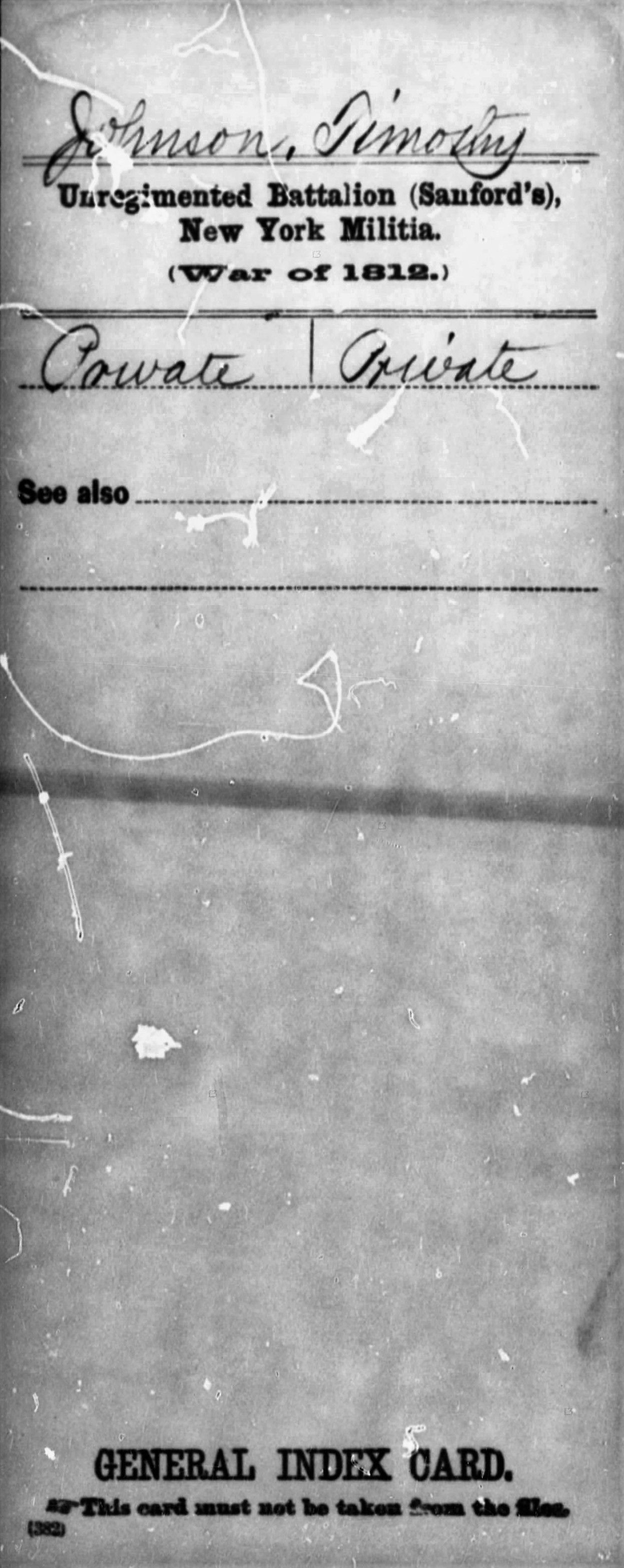
After the war, in 1816, Timothy Johnson went south and spent parts of two years in Virginia, North Carolina, South Carolina, and Georgia. He returned to Turin about 1818 and settled on a farm in the town of Barre, Genesess County, New York (Barre is now in Orleans County)
When he was 25, he married Lucretia Brownell, daughter of Pierce Brownell and Margaret Spike, about 1818 in Rochester, Monroe, New York.
Timothy Johnson and Lucretia Brownell had the following children:
- Charlotte Johnson was born on 14 Sep 1820 in Genesee, New York. She married Philander Baldwin in 1838 in Watertown, Jefferson, Wisconsin. She married William Henson Thomas after 17 Apr 1877 in Iowa. She died on 29 Feb 1904 in Sac, Iowa.
- Henry Johnson was born in 1824 in Rochester, Monroe, New York. He died on 25 Mar 1898 in Pittsville, Wood, Wisconsin.
- Elizabeth Johnson was born on 14 Nov 1826 in Rochester, Monroe, New York. She died on 24 Dec 1873 in Watertown, Jefferson, Wisconsin.
- Jane Melissa Johnson was born on 14 Aug 1827 in Rochester, Monroe, New York. She married John A. Chadwick on 15 Nov 1842 in Watertown, Jefferson, Wisconsin. She died of acute bronchitis on 15 Apr 1898 in Watertown, Jefferson, Wisconsin.
- Mary Johnson was born about 1830. She died in May 1845 in Watertown, Jefferson, Wisconsin.
- Seymour Johnson was born about 1832. He died before 1871.
- Alzina N. Johnson was born on 19 Aug 1835 in Montville, Medina, Ohio. She married Dwight Goodrich in 1857 in Watertown, Jefferson, Wisconsin. She married George Washington Wylly on 25 Dec 1875. She died on 17 Dec 1917 in Orlando, Brevard, Florida.
- Charles Johnson was born on 25 Aug 1838 in Watertown, Jefferson, Wisconsin. He was the first white child born in Watertown. He married Margaret Robinson Hayhurst on 25 Aug 1862 in Wisconsin. He died on 19 Nov 1924 in Milwaukee, Milwaukee, Wisconsin.
- John Brownell Johnson was born on 08 Nov 1841 in Wisconsin. He married Ida Isabell Gilbert on 27 Dec 1892 in Fond du Lac, Fond du Lac, Wisconsin. He married Francess Sybel Barrett on 13 Sep 1897 in Jefferson, Wisconsin. He died on 25 Jun 1932 in Minneapolis, Hennepin, Minnesota.
As newlyweds, Lucretia and Timothy Johnson settled into their farm at Barre, New York. They were there at the time of the 1820 Federal Census.
But, Timothy wasn’t satisfied there…
After four or five years, he sold his farm and bought a different one in Greece, Monroe, New York, a few miles west of Rochester, New York.
But, Timothy wasn’t satisfied there…
After a few years, he exchanged his Greece farm for property in the “wild lands” of Ohio. The family moved to Montville, Medina, Ohio in 1828. They lived there at the time of the 1830 Federal Census.
But, Timothy wasn’t satisfied there…
Sometime around 1835, he wanted to move again. He explored Maumee County, Ohio, but didn’t find anything that interested him, so he traveled farther and farther west and ended up in Wisconsin.
Timothy, himself, told the story of his travels.
I have thought that a brief sketch of my life previously to immigrating to this county, might not be inappropriate.
I was born in Middletown, Conn., on the 28th of June, 1792. When I was 10 years of age, my father removed to the town of Turin, Lewis co., N.Y. In 1816 I went south, and after spending portions of two years in Virginia, North Carolina, South Carolina and Georgia, I returned to Turin, and in 1818 settled on a farm in the town of Barre, Genesess (now Orleans) co. Some four or five years afterward, I sold my farm, and purchased another in the town of Greece, Monroe co., a few miles west of Rochester. I subsequently exchanged this farm with Aristarchus Champion, for wild lands in the town of Montville, Medina co., Ohio, wither I removed in 1828.
After being in Montville about seven years, I visited the Maumee country, in search of a farm, but as it did not meet my expectations, I continued my journey westward, and reached Racine, in this state, in January, 1836, coming around by land. I may here mention, that the stage in which I took passage from Detroit to Chicago, was the first that even ran day and night between those two points, and that this was its first trip.
At Racine, a village at that time composed of three or four shanties, I found a few old acquaintances, one of whom—John Inman—owned a claim in Wisconsin City, situated some three miles below Janesville, on Rock River—a city, by the way, which at that time existed only in the imagination, not having been lithographed nor even surveyed. I was induced to visit the place, and in company with Mr. Inman, Dr. Heath and his wife, two brothers by the name of Smith, and another man whose name I have forgotten, started for the “city,” and reached the house of Samuel St. John, about a mile above the place we were in search of, on the fourth night—January 16th, 1836. Mr. St. John had come in from Vermont a few months before, his wife being the first white woman to settle in that portion of Rock River valley lying within the bounds of this state.
Solomon Juneau, Milo Jones, Thomas Holmes, and three or four companions stopped with Mr. St. John the same night. They had been up the river as far as Jefferson, examining the country. At that time there had not been a claim made between Racine and the river.
A few days afterward I went down to Squaw Prairie (now Belvidere,) Illinois. I found no inhabitant in the distance thus traveled, some 30 miles by the trail I took, except an Indian trader by the name of Tabeaux, a Frenchman, who had located where Beloit now stands. I subsequently made three excursions west, one of which was extended as far as Mineral Point. The population was very sparse. From Mr. St. John’s to Sugar River Diggings, some 24 miles, I did not find a settler, and but three at the diggings—Kemp, Collins and Welch.
Sometime in February, I purchased at Rockford provisions and complements for shantee-keeping—432 lbs. of pork, 300 of flour, 6 of coffee, 3 of tea, 16 of sugar, a bake kettle, spider, frying pan, tea kettle, two pails, knives, forks, spoons, plates, cups, saucers, &c. I do not recollect the price I paid for them, but their transportation to Mr. St. John’s, a distance of 22 miles, cost me $20.
In February, I came up the river, and erected a shantee on the east side of the stream, about two miles below the present village of Jefferson, and nearly opposite the present residence of Capt. Robert Masters. This completed, I made a number of excursions into the country. In one of them I visited the present site of the village of Watertown. The eastern half of the river was covered with ice. Falling a tree which stood near the present saw mill of Patrick Rogan, across the unfrozen current, I passed over to the eastern bank of the stream, which I followed down to my shantee. On that occasion I was 48 hours without food, having been robbed of my provisions near Mud Lake by the Indians. On my way down, I examined the country around the stream now known as Johnson’s Creek, (it afterward having taken my name,) and the next season made a claim near its mouth—building a cabin and chopping some three acres of land. I had previously made claims at Aztalan and Jefferson, and subsequently one at Watertown—the latter covering about 1000 acres, including the water power and the ground upon which the village now stands. My claim at Aztalan, which I sold in July, 1836, to James Brayton and Judge Hyer, included the “ancient city.” I was probably the first white man to discover those ruins. My claim at Watertown I sold to Messrs. Goodhue and Chapin, toward the close of 1836.
Soon after having built my cabin at Johnson’s Creek, the Indians found a Polander in the Bark River woods, badly frozen, and showing but few signs of life. They put him into their canoe, and after entering the Rock, followed it up to my cabin, and left him.—He remained with me about two months, having by that time recovered his health and strength, though he lost several of his toes and a large portion of the flesh on his feet. Our provisions failing us while he was with me, we subsisted upon boiled herbs for seven days in succession.
The last of May or the first of June, I went to Milwaukee and purchased a load of provisions, a yoke of oxen and a wagon—going and returning by way of Fort Atkinson, Rock Prairie and Makwonago. At that time there was no settlement between my cabin and Prairieville, (now Waukesha,) and but three or four cabins at that place. Soon after, Col. Meacham settled at Honey Creek, upon the prairie which now bears his name. He was, I think, the first white settler in that portion of Wisconsin included within the present limits of the county of Walworth.
During the same summer I cut a road, with the assistance of three hired men—Philander Baldwin, Reeve Griswold and Charles Seaton—from Jefferson to Watertown, on the east side of the river, and one from Jefferson to a point near the present tavern stand of Austin Kellogg,, in the town of Concord. Striking the extensive tamarack swamp there, which we regarded as impassable, we abandoned our intention of opening a road to Milwaukee.
During the summer I built a cabin within the present village of Watertown, and erected the body and laid the floor of the log house now standing on my farm, on the west side of the river, about three fourths of a mile south of the village. In the fall I sent for my family. About the time I expected them to arrive at Milwaukee; I started for that place on horseback, following the Indian trails through Ixopia, Oconomowoc and Summit, to Prairieville. I do not think that any white man had previously passed over that route. There was at that time no inhabitant between Watertown and Prairieville. Having been thrown from my horse in fording the Oconomowoc River, wetting me to the skin and rendering useless my fire matches, I passed a cold, comfortless night, encamped by the side of a log near the junction of the Twin Lakes.
On reaching Milwaukee, I found my family had been there two days. I hired a man to carry them to Prairieville, where they remained about four weeks. I then hired their conveyance to the upper lake, on the Oconomowoc. At that place I and my men dug out five poplar canoes, each 21 feet long, and built a red cedar raft capable of bearing two or three tons’ weight, expecting to find little or no difficulty in floating them down the Oconomowoc and Rock to Watertown, with my family furniture and provisions. But I was mistaken.—As we passed out of the lake, we found the water quite shallow, and some days did not travel to exceed 80 rods.
We camped nights on the shore, and usually cooked provisions enough to last us through the following day. We reached the head of the lower lake, where the village of Oconomowoc now stands, on the night of the fifth day after leaving the upper lake. That night was intensely cold, and in the morning we found the lake covered with ice strong enough to bear a man. Of course, we were compelled to abandon our expectations of reaching Watertown by water. So, leaving my family in a tent under charge of one of my men, (Mr. Griswold,) I and Mr. Miller started for Watertown after my ox team, to convey my family thither, by land. Returning to Oconomowoc with the team, I took my family and a portion of my goods and started for Watertown. At a stream now known as Battletown Creek, about three miles from Oconomowoc, we found it necessary to build a cabin for our accommodation, until we could bridge that stream. We were thus detained three or four days. We also cut the road all the way from that point to Watertown, which place we were three weeks and three days in reaching, from the time we left Prairieville. The road thus opened was the only one traveled between Watertown and Prairieville for many years; and for a long time was the cabin alluded to, the only building on the road.Battletown Creek received its name from the following incident: A little difficulty occurred at the cabin one night, while we were building the bridge, between one of my men by the name of Gardner and myself, ending in a “clinch” in which I obtained the advantage of my antagonist. No blood was spilt, however, no bones broken. The next morning one of my men wrote with a piece of red chalk, on the top of a stump near the cabin, “Battletown.” The creek thus took its name, which it has borne ever since.
I might have stated before, that my family landed at Watertown on the night of the 10th of December, 1836. Mrs. Johnson was the first white woman who settled in that town.
Finally, Timothy Johnson put down some roots. He was the founder of Watertown, Wisconsin. The town was originally called Johnson’s Rapids, but later changed to Watertown by the request of a majority of its citizens who had come from Watertown, New York. Timothy and family were recorded in the 1840 and 1850 Federal Censuses at Watertown.
But, Timothy wasn’t satisfied there…
In 1856, Timothy Johnson left Watertown for Northwestern Wisconsin. In its 23 Oct 1856 edition, the Watertown Democrat described Timothy’s new venture.
The Old Pioneer Takes One Journey More
This week, Timothy Johnson, the first settler of Watertown, leaves this city for his new and far North Western home near the frontier boundary of the state, on Wolf creek – a beautiful stream, with a valuable water-privilege, on whose banks he has selected his final residence, and which flows into the Mississippi. At a time of life when most men seek retirement and repose, the Old Pioneer forsakes the spot he has seen rise from a beginning when himself was the only white man on it to a place of ten thousand inhabitants, and goes to a distant country, primitive as undisturbed nature can make it, there again, in the midst of the new world of strange scenery that will surround him, to commence the work of introducing another and better order of things.
An emperor of long-fallen Rome once said that he came to a city built of straw and left it built of marble. Our still surviving founder can make a nobler boast than that. He came here twenty years ago and beheld a wilderness without a city, and now, after having laid its foundations and watched over its growth thus far, he leaves a city without wilderness – a city rich in all the resources of civilization, and gradually drawing around itself whatever has a tendency to elevate and refine an enlightened community.
In thus bidding farewell to a fellow townsman whose name has always been so intimately identified with the city within those limits he was the first to make a permanent home, it may be appropriate to give a short sketch of one whose familiar presence we shall soon miss.
Timothy Johnson was born in Middleton, Middlesex county, Connecticut, on the 28th of June, 1792, and is consequently now in the sixty fifth year of his age. When only ten years old, he came with his parents to Turin, Lewis county, New York, then a new country, and just beginning to be broken into by the increasing tide of New England settlers. In 1811, he was on the ground where Rochester now stands, which then contained only one house – all else being a vast and untenanted solitude. In 1816, he removed to Montville, in Medina county, Ohio, which state was then favorite resort of such as sought new homes in the West. Here he remained for twenty years, following ordinary pursuits, until the stories of a new, beautiful and fertile land beyond lake Michigan began to be rumored abroad and excite his restless curiosity, ever on the lookout for something novel, exciting and adventurous.
The fame of Wisconsin at length reached his ears, and he resolutely determined to explore its magnificent forests, broad prairies and lovely lakes for himself. He visited various portions of it, and for weeks was a solitary roamer over its then untraveled surface. He threaded the valley of the Rock river, and was unsatisfied until his eye rested on the ground on which the city of Watertown has sprung into existence. His quick and sure observation told him that here was a place the combined all the elements of a flourishing town. Here was an ever flowing stream, capable of being turned to various manufacturing purpose on the most extensive scale; here was a soil certain to yield the largest and finest crops; here were extensive ranges of heavy timber, ready to be transformed into good building material; here was a mild, healthy, delightful climate; and what more could any one desire who was longing for an unoccupied field of enterprise. On the 10th of November, 1836, he pitched his tent here in the midst of falling snow and a hundred Winnebag wigwams. He has lived here ever since – a kind-hearted and obliging neighbor, ever-ready to extend a helping hand and relieve distress—an active and liberal minded man – a useful and respected citizen. The Indians who made this their charmed resort have disappeared, and the Anglo-Americans have taken possession of their lands. All has been changed. Our citizens know the rest—they know how family has followed family—how roads have been opened in all directions—how towering woods have been cut down—how houses have been put up—how days of scarcity have been followed by days of plenty—how mills and manufactures have been erected along the length of our never failing water-course—how the promising germs of institutions of learning for the education of the young have been planted—how temples of worship have arisen—how the solitary cottage of the first lonely pioneer was quickly made happy and cheerful by the log cabins of the new comers—how the narrow trail has been succeeded by the iron way—how the scattered settlements clustered into a hamlet—how the hamlet grew into a village—how the village enlarged into a city—though that city, with all its railroads, telegraphs, gas-works, elegant mansions, magnificent blocks, and many other characteristics of an advancing seat of enterprise and wealth, is hardly yet in the middle of its onward career. And now having witnessed all these wonderful revolutions, he bids adieu to the theatre of such peaceful triumphs of industry and intelligence, and voluntarily goes where the same incidents in the tragedy of life are to be enacted over once more before the here passes from the stage. With a form slightly bent down with the weight of years, a countenance bearing the traces of care and labor, but with a spirit as hopeful and firm as ever, with a light step, the gallant old pioneer starts away to make another experiment at empire-building, hundreds of miles further towards the setting sun. Prosperity crows his efforts. May he long live and often revisit us. We know he will never receive any other than the most hearty and cordial welcome whenever he makes his appearance in our midst.
Timothy left Watertown alone, with intentions of building a house and having Lucretia join him there later. But, it wasn’t to be. Lucretia Brownell Johnson died at Watertown on 2 Nov 1857. Word of her death probably did not reach him for some time. Her obituary included a reference to Timothy stating, “...while the still persevering companion of her youth, in the closing evening of her days, is yet far away in the solitudes of the North West — perhaps laying the foundations of another city — all unmindful of the sad disposition that has just afflicted him with an irreparable loss, and will forever cast a deep gloom over and render lonely and desolate the distant home he was preparing for the now gone but life-long sharer of his strange vicissitudes of fortune.“
On 1 Feb 1860, Timothy Johnson was granted 160-acres of land near Sterling, Polk, Wisconsin. The grant was given as reward for his service in the War of 1812.
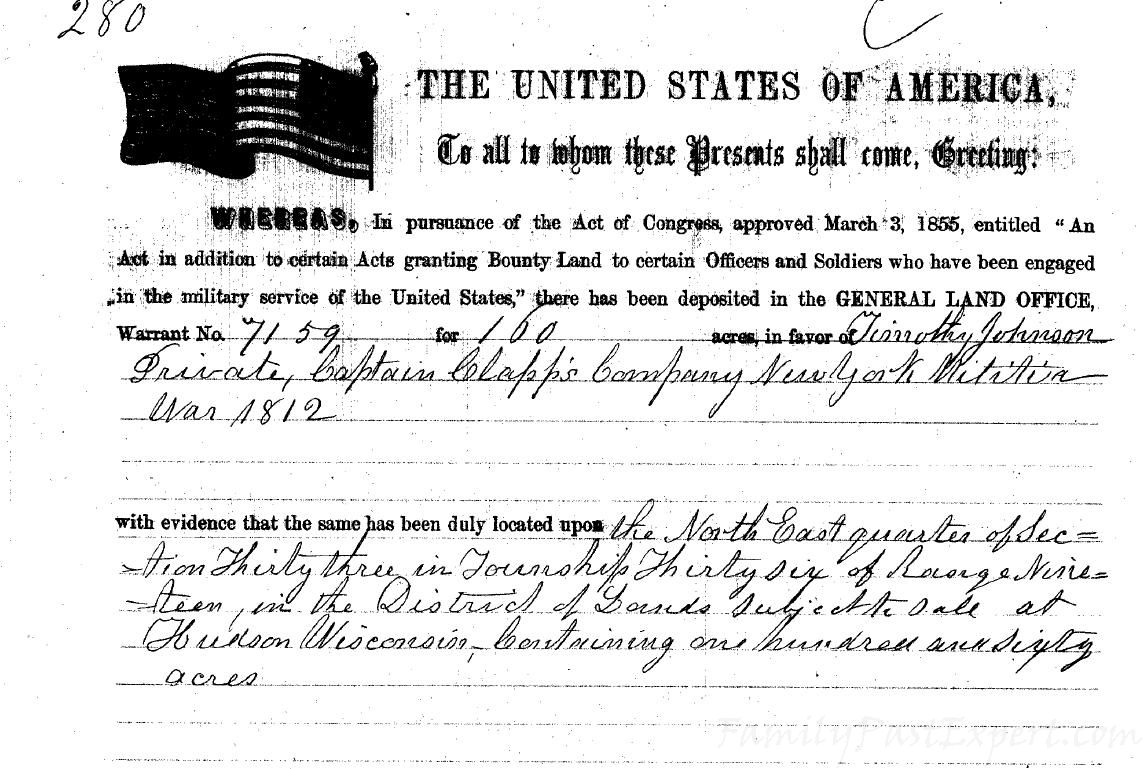
Though he left Watertown, Timothy Johnson returned periodically for visits. By 1870, old age had caught up with him and he was living in a state hospital in Westport, Dane, Wisconsin. He died there on 29 Jan 1871. He was buried about Feb 1871 in Oak Hill Cemetery, Watertown, Jefferson, Wisconsin. His obituary was published in the Watertown Democrat.
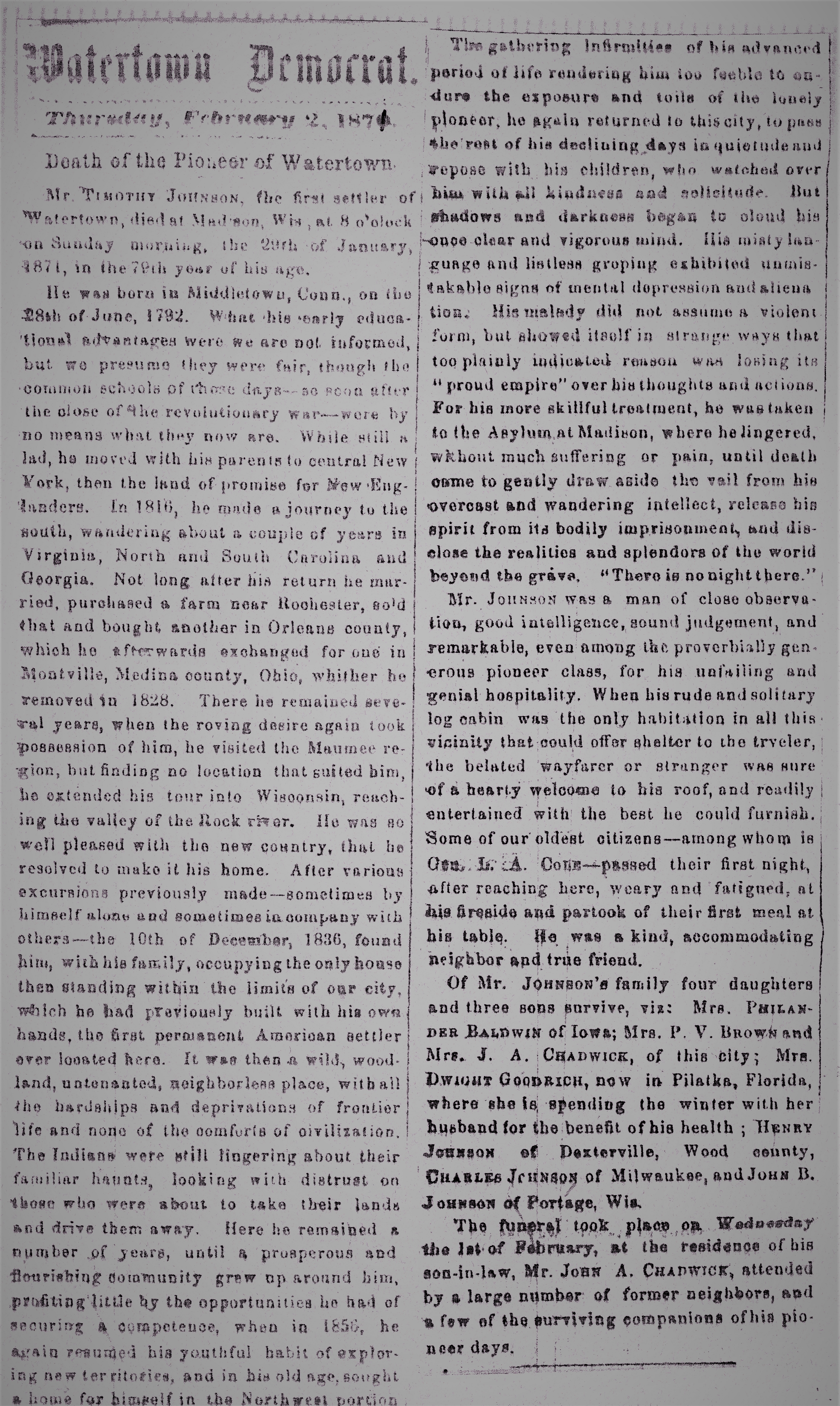
Where is he in the tree?
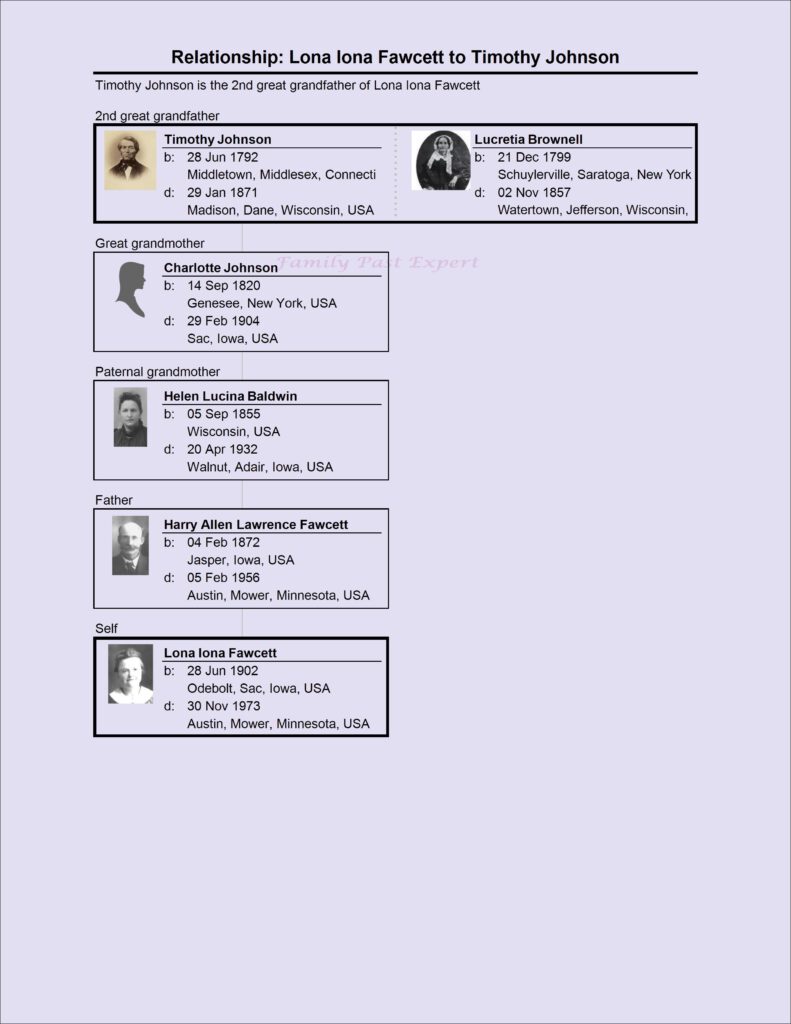
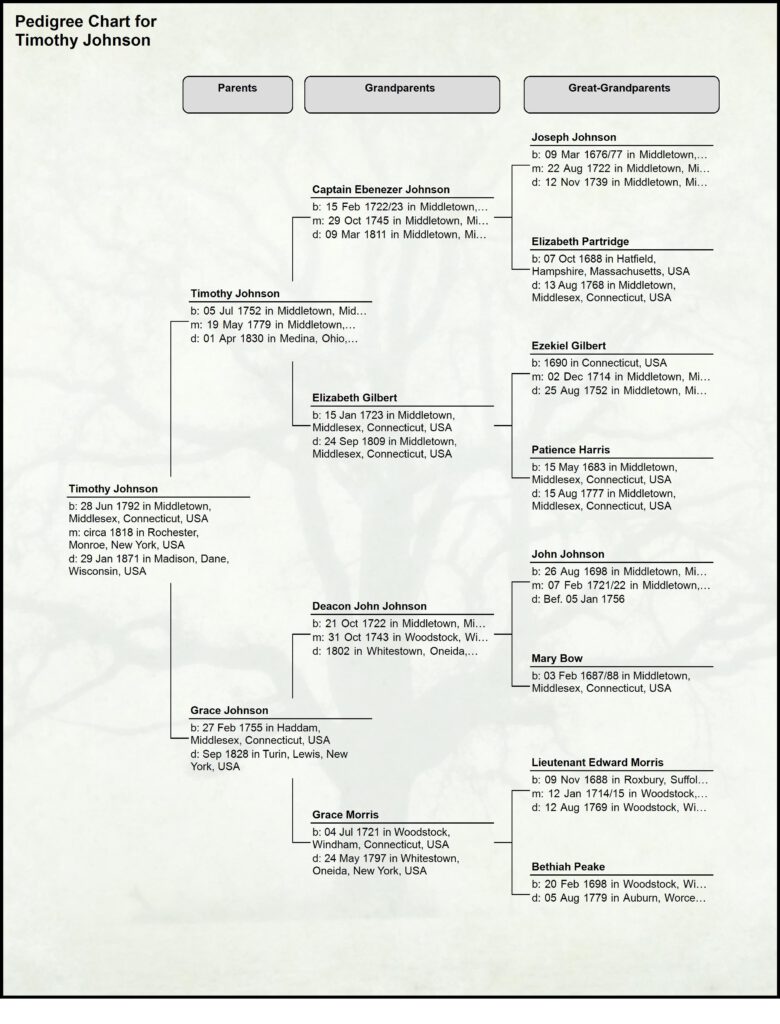
Selected Sources:
“A History of Jefferson County, Wisconsin: Containing a History of Jefferson County, Its Early Settlement, Growth, Development, Resources, Etc.,” (Jefferson County Wisconsin: Western Historical Company, 1879) digital images, pp. 335-6, 342, 345, 347, 351, 400-7, 442-3, Google Books (https://books.google.com/books?id=4hUrAQAAMAAJ : accessed 19 Jun 2017).
Franklin B. Hough, “A History of Lewis County in the State of New York from the Beginning of its Settlement to the Present Time” (Albany: Munsell & Rowland, 1860) digital images, pp. 299-300, Google Books (https://books.google.com/books?id=QJFaV1omSEUC : accessed 19 Jun 2017).
“Obituary: Lucretia Johnson”. (1857, November 5). Watertown Democrat.
“Second Annual Pioneer Festival”. (1851, January 22). Watertown Chronicle , p. 1.
“The Militia of Lewis County, NY,” Ray’s Place, Web, 19 Jun 2017, http://history.rays-place.com/ny/lewis-militia.htm. From: History of Lewis County, New York and its people by Franklin B. Hough, published by D. Mason & Co. 1883.
“The Old Pioneer Takes One Journey More”. (1856, October 23). Watertown Democrat.
“War of 1812,” History, Web, 19 Jun 2017, http://www.history.com/topics/war-of-1812.


Leave a Reply